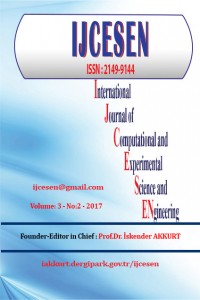Öz
Although
there are many blade profile have been improved for use in aviation and energy
sector, there is still needed blade profiles which have higher performance
especially the commercial horizontal axis wind turbine efficiency is taken into
account. The purpose of this study is to obtain the new blade profiles which
have higher lift (CL) and drag (CD) coefficients for wind turbine making
geometric modifications on several NACA wing profile systematically. For this
purpose, the performance of NACA and developed new profiles have been compared
with each other using computational fluid dynamics analysis and it is seen that
the new developed profiles have higher performance than NACA profiles. Later
on, according to the Blade Element Momentum Theory (BEM Theory) turbine blades
are designed with developed new profiles and 3-dimensional CFD analyses are
performed. Increase in torque in the wind turbine is determined.
Anahtar Kelimeler
Kaynakça
- [1] K.Y. Maalawi, M.T.S. Badawy, “A direct method for evaluating performance of horizontal axis wind turbines”, Renew. Sustain. Energy Rev. 5 (2001) 175–190. doi:10.1016/S1364-0321(00)00017-4.
- [2] A. Erişen, M. Bakirci, NACA 0012 VE NACA 4412 Kanat Kesitlerinin Yeniden Tasarlanarak Had ile Analiz Edilmesi, J. Eng. Technol. Sci. 50–82.
- [3] M. Jureczko, M. Pawlak, A. Mężyk, “Optimisation of wind turbine blades”, J. Mater. Process. Technol. 167 (2005)463–471. doi:10.1016/j.jmatprotec.2005.06.055.
- [4] W. Xudong, W.Z. Shen, W.J. Zhu, J.N. Sørensen, C. Jin, “Shape optimization of wind turbine blades”, Wind Energy. 12 (2009) 781–803. doi:10.1002/we.335.
- [5] A. Varol, C. İlkılıç, Y. Varol, “Increasing the efficiency of wind turbines”, J. Wind Eng. Ind. Aerodyn. 89 (2001) 809–815. doi:10.1016/S0167-6105(01)00069-1.
- [6] M.M. Duquette, K.D. Visser, “Numerical Implications of Solidity and Blade Number on Rotor Performance of Horizontal-Axis Wind Turbines”, J. Sol. Energy Eng. 125 (2003) 425. doi:10.1115/1.1629751.
- [7] E. Benini, A. Toffolo, “Optimal Design of Horizontal-Axis Wind Turbines Using Blade-Element Theory and Evolutionary Computation”, J. Sol. Energy Eng. 124 (2002) 357. doi:10.1115/1.1510868.
- [8] X. Liu, Y. Chen, Z. Ye, “Optimization model for rotor blades of horizontal axis wind turbines”, Front. Mech. Eng. China. 2 (2007) 483–488. doi:10.1007/s11465-007-0084-9.
- [9] K. Kishinami, H. Taniguchi, J. Suzuki, H. Ibano, T. Kazunou, M. Turuhami, “Theoretical and experimental study on the aerodynamic characteristics of a horizontal axis wind turbine”, in: Energy, 2005: pp. 2089–2100. doi:10.1016/j.energy.2004.08.015.
- [10] M. Guleren, S. Demir, “Rüzgar türbinleri için düşük hücum açılarında farklı kanat profillerinin performans analizi”, Isı Bilim. ve Tek. Derg. 31 (2011) 51–59.
- [11] P. Devinant, T. Laverne, J. Hureau, “Experimental study of wind-turbine airfoil aerodynamics in high turbulence”, J. Wind Eng. Ind. Aerodyn. 90 (2002) 689–707. doi:10.1016/S0167-6105(02)00162-9.
- [12] L. Bermudez, A. Velázquez, A. Matesanz, “Numerical simulation of unsteady aerodynamics effects in horizontal-axis wind turbines”, Sol. Energy. 68 (2000) 9–21. doi:10.1016/S0038-092X(99)00056-0.
- [13] I. Ansys, ANSYS FLUENT theory guide, Knowl. Creat. Diffus. Util. 15317 (2009) 724–746. doi:10.1016/0140-3664(87)90311-2.
- [14] J.F. Manwell, J.G. McGowan, A.L. Rogers, “Wind energy explained: theory, design and application”, 2009. doi:10.1002/9781119994367.
- [15] T.C. Yenilenebilir Enerji Genel Müdürlüğü, http://www.eie.gov.tr/.
Öz
Kaynakça
- [1] K.Y. Maalawi, M.T.S. Badawy, “A direct method for evaluating performance of horizontal axis wind turbines”, Renew. Sustain. Energy Rev. 5 (2001) 175–190. doi:10.1016/S1364-0321(00)00017-4.
- [2] A. Erişen, M. Bakirci, NACA 0012 VE NACA 4412 Kanat Kesitlerinin Yeniden Tasarlanarak Had ile Analiz Edilmesi, J. Eng. Technol. Sci. 50–82.
- [3] M. Jureczko, M. Pawlak, A. Mężyk, “Optimisation of wind turbine blades”, J. Mater. Process. Technol. 167 (2005)463–471. doi:10.1016/j.jmatprotec.2005.06.055.
- [4] W. Xudong, W.Z. Shen, W.J. Zhu, J.N. Sørensen, C. Jin, “Shape optimization of wind turbine blades”, Wind Energy. 12 (2009) 781–803. doi:10.1002/we.335.
- [5] A. Varol, C. İlkılıç, Y. Varol, “Increasing the efficiency of wind turbines”, J. Wind Eng. Ind. Aerodyn. 89 (2001) 809–815. doi:10.1016/S0167-6105(01)00069-1.
- [6] M.M. Duquette, K.D. Visser, “Numerical Implications of Solidity and Blade Number on Rotor Performance of Horizontal-Axis Wind Turbines”, J. Sol. Energy Eng. 125 (2003) 425. doi:10.1115/1.1629751.
- [7] E. Benini, A. Toffolo, “Optimal Design of Horizontal-Axis Wind Turbines Using Blade-Element Theory and Evolutionary Computation”, J. Sol. Energy Eng. 124 (2002) 357. doi:10.1115/1.1510868.
- [8] X. Liu, Y. Chen, Z. Ye, “Optimization model for rotor blades of horizontal axis wind turbines”, Front. Mech. Eng. China. 2 (2007) 483–488. doi:10.1007/s11465-007-0084-9.
- [9] K. Kishinami, H. Taniguchi, J. Suzuki, H. Ibano, T. Kazunou, M. Turuhami, “Theoretical and experimental study on the aerodynamic characteristics of a horizontal axis wind turbine”, in: Energy, 2005: pp. 2089–2100. doi:10.1016/j.energy.2004.08.015.
- [10] M. Guleren, S. Demir, “Rüzgar türbinleri için düşük hücum açılarında farklı kanat profillerinin performans analizi”, Isı Bilim. ve Tek. Derg. 31 (2011) 51–59.
- [11] P. Devinant, T. Laverne, J. Hureau, “Experimental study of wind-turbine airfoil aerodynamics in high turbulence”, J. Wind Eng. Ind. Aerodyn. 90 (2002) 689–707. doi:10.1016/S0167-6105(02)00162-9.
- [12] L. Bermudez, A. Velázquez, A. Matesanz, “Numerical simulation of unsteady aerodynamics effects in horizontal-axis wind turbines”, Sol. Energy. 68 (2000) 9–21. doi:10.1016/S0038-092X(99)00056-0.
- [13] I. Ansys, ANSYS FLUENT theory guide, Knowl. Creat. Diffus. Util. 15317 (2009) 724–746. doi:10.1016/0140-3664(87)90311-2.
- [14] J.F. Manwell, J.G. McGowan, A.L. Rogers, “Wind energy explained: theory, design and application”, 2009. doi:10.1002/9781119994367.
- [15] T.C. Yenilenebilir Enerji Genel Müdürlüğü, http://www.eie.gov.tr/.
Ayrıntılar
| Birincil Dil | İngilizce |
|---|---|
| Konular | Mühendislik |
| Bölüm | Araştırma Makalesi |
| Yazarlar | |
| Yayımlanma Tarihi | 15 Aralık 2017 |
| Gönderilme Tarihi | 26 Ekim 2017 |
| Kabul Tarihi | 28 Ekim 2017 |
| Yayımlandığı Sayı | Yıl 2017 Cilt: 3 Sayı: 2 |

